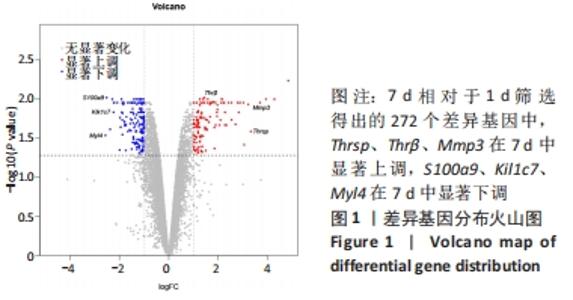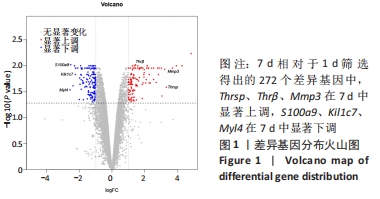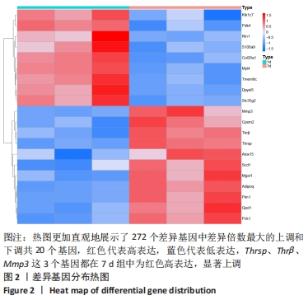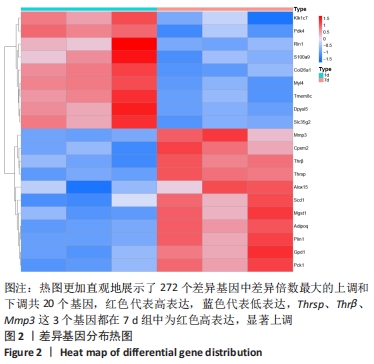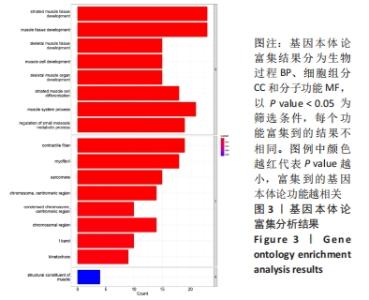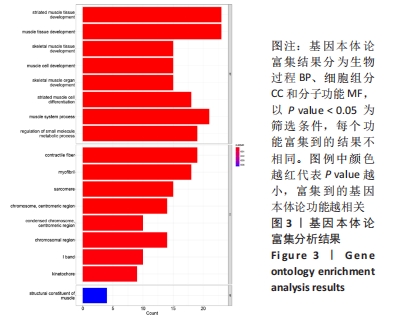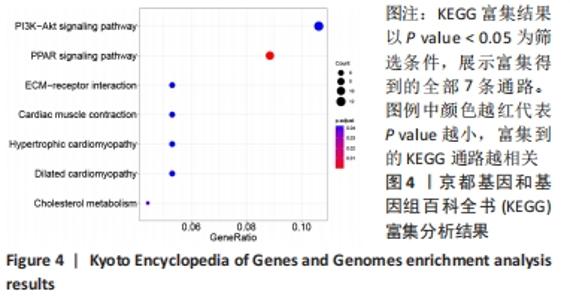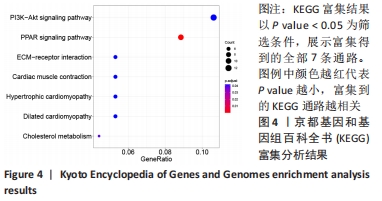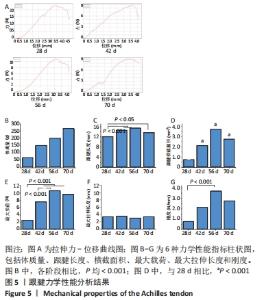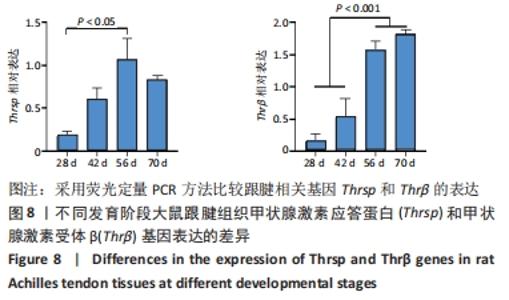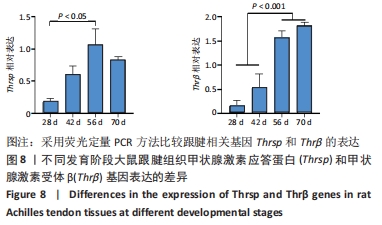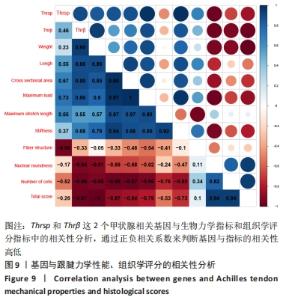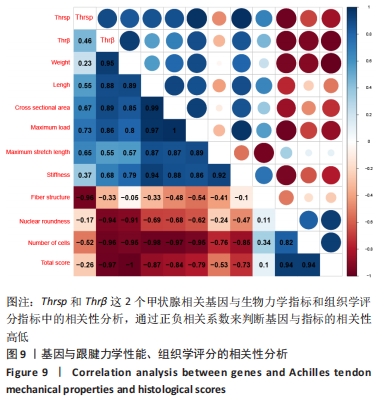Chinese Journal of Tissue Engineering Research ›› 2023, Vol. 27 ›› Issue (11): 1653-1658.doi: 10.12307/2023.091
Previous Articles Next Articles
Correlation analysis between thyroid function-related Thrβ and Thrsp genes and mechanical properties of Achilles tendon development in rats
Niu Jingwei1, Zhang Qingtao1, Wang Na1, Guan Shuo1, Wang Ying1, 2
- 1School of Biomedical Engineering, Taiyuan University of Technology, Taiyuan 030024, Shanxi Province, China; 2Shanxi Bethune Hospital, Shanxi Academy of Medical Sciences, Tongji Shanxi Hospital, Third Hospital of Shanxi Medical University, Taiyuan 030032, Shanxi Province, China
-
Received:2022-02-24Accepted:2022-04-23Online:2023-04-18Published:2022-09-26 -
Contact:Wang Ying, PhD, Lecturer, School of Biomedical Engineering, Taiyuan University of Technology, Taiyuan 030024, Shanxi Province, China; Shanxi Bethune Hospital, Shanxi Academy of Medical Sciences, Tongji Shanxi Hospital, Third Hospital of Shanxi Medical University, Taiyuan 030032, Shanxi Province, China -
About author:Niu Jingwei, Master candidate, School of Biomedical Engineering, Taiyuan University of Technology, Taiyuan 030024, Shanxi Province, China -
Supported by:the National Natural Science Foundation of China, No. 11602159 (to WY); Shanxi Provincial Special Postdoctoral Fund (to WY); Shanxi Bethune Hospital Postdoctoral Research Start-up Fund (to WY)
CLC Number:
Cite this article
Niu Jingwei, Zhang Qingtao, Wang Na, Guan Shuo, Wang Ying. Correlation analysis between thyroid function-related Thrβ and Thrsp genes and mechanical properties of Achilles tendon development in rats[J]. Chinese Journal of Tissue Engineering Research, 2023, 27(11): 1653-1658.
share this article
Add to citation manager EndNote|Reference Manager|ProCite|BibTeX|RefWorks
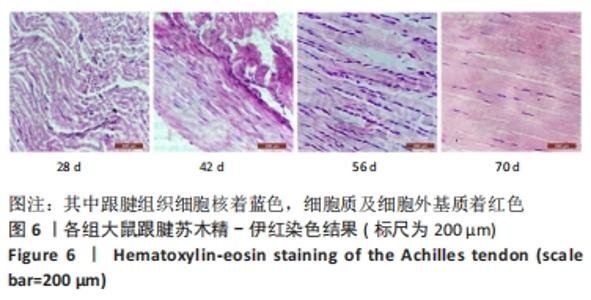
通过对不同生长阶段大鼠的体质量、跟腱长度、跟腱截面积比较,结果显示随着生长发育的进行,28,42,56,70日龄大鼠的体质量、跟腱长度、跟腱截面积均呈现逐渐增长的趋势,见图5B-D。其中,体质量在各个阶段差异均极显著;跟腱长度和截面积均为28日龄时跟其他日龄比较差异均有显著性意义,42,56,70日龄跟腱长度与截面积变化差异不显著。通过体外拉伸实验,分别对不同阶段大鼠的跟腱进行拉伸,结果显示,不同生长阶段大鼠所能承受的最大载荷和刚度基本呈现逐渐增大的趋势,最大载荷在28,42,56日龄阶段时差异均极显著;刚度在28日龄与56日龄时差异极显著;最大拉伸长度在各组间基本一致,差异不显著。 综上所述,随着大鼠的生长发育,即使体质量发生了显著的变化,但其后肢跟腱的长度和截面积并不会呈现显著增大的趋势,到一定的生长阶段后将保持基本不变;其所能承受的最大载荷和跟腱组织刚度都随着大鼠生长发育到一定程度后,不再显著变化,见图5E-G。 2.5 苏木精-伊红染色 染色结果显示不同生长阶段的大鼠跟腱有着较为显著的形态学变化,见图6。跟腱组织细胞核着蓝色,核所占比重较小,细胞质及细胞外基质着红色,因此细胞大部分成分都是细胞外基质。从细胞的纤维结构、核圆度、细胞数量3个参数来进行半定量评价。 "
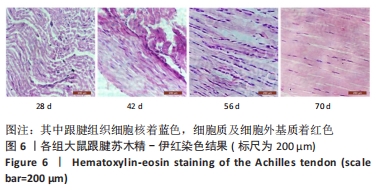
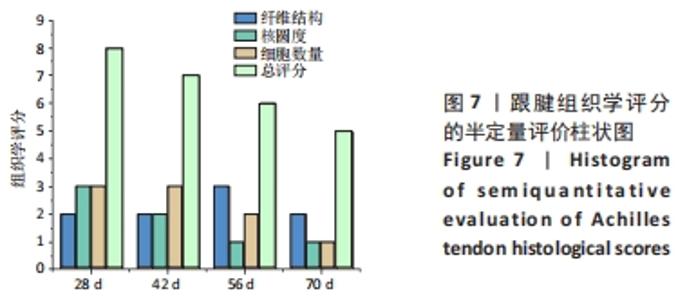
跟腱纤维结构:随着大鼠的生长发育,伴随着新纤维的沉积,组织结构变得更加致密和规则。28,42日龄时跟腱组织排列疏松,呈轻度微波浪卷曲状,但排列稍显紊乱且相邻之间的空隙比较大,而56,70日龄时跟腱组织排列规则整齐呈平行状,卷曲模式短,胶原纤维紧密相接,空隙较小,含量丰富且波浪状消失胶原纤维明显平行、致密,卷曲模式趋于消失。 核形态:28日龄时核形态基本仍呈圆形,42日龄时呈现出短纺锤形,第56,70日龄时转变为长纺锤形。 细胞数量:随着发育而减少,70日龄肌腱组织中细胞数量最少,它们被密集的胶原纤维包围。 比较上述3个参数在各时间点的组织学评分,见图7。除纤维结构外,各参数得分随时间下降;最低值出现在第70天。 "
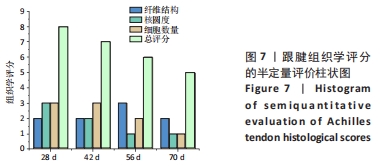
| [1] BRENT GA. Tissue-specific actions of thyroid hormone: insights from animal models. Rev Endocr Metab Disord. 2000;1:27-33. [2] BAY-JEXNSEN A, SLAGBOOM E, CHEN-AN P, et al. Role of hormones in cartilage and joint metabolism: understanding an unhealthy metabolic phenotype in osteoarthritis. Menopause. 2013;20:578-586. [3] YEN PM. Physiological and molecular basis of thyroid hormone action. Physiol Rev. 2001;81:1097-1142. [4] BUYUKSIRECI DE, TECER D, BOLAYIR B, et al. Ultrasonographic evaluation of shoulder tendons in patients with Hashimoto’s disease. Int J Rheum Dis. 2020;23:1497-1504. [5] YAO Z, LI J, WANG X, et al. MicroRNA-21-3p Engineered Umbilical Cord Stem Cell-Derived Exosomes Inhibit Tendon Adhesion. J Inflamm Res. 2020; 13:303-316. [6] LEE M, MAAHS D. 50 Years Ago in TheJournal ofPediatrics: The Achilles Reflex Time in Thyroid Disorders. J Pediatr. 2020;217:78. [7] ANWAR S, GIBOFSKY A. Musculoskeletal Manifestations of Thyroid Disease. Rheum Dis Clin North Am. 2010;36:637-646. [8] OLIVA F, GIAI VIA A, MAFFULLI N. Calcific Tendinopathy of the Rotator Cuff Tendons. Sports Med Arthrosc Rev. 2011;19:237-243. [9] MILGROM C, NOVACK V, WEIL Y, et al. Risk factors for idiopathic frozen shoulder. Isr Med Assoc J. 2008;10:361-364. [10] KNOPP W, BOHM M, MCCOY J. Hypothyroidism presenting as tendinitis. Phys Sportsmed. 1997;25:47-55. [11] PURNELL D, DALY D, LIPSCOMB P. Carpal-tunnel syndrome associated with myxedema. AMA Arch Intern Med. 1961;108:751-756. [12] GARRITY J, BAHN R. Pathogenesis of graves ophthalmopathy: implications for prediction, prevention, and treatment. Am J Ophthalmol. 2006;142:147-153. [13] SALVI M, GIRASOLE G, PEDRAZZONI M, et al. Increased serum concentrations of interleukin-6 (IL-6) and soluble IL-6 receptor in patients with Graves’ disease. J Clin Endocrinol Metab. 1996;81:2976-2979. [14] DIEZ J, HERNANZ A, MEDINA S, et al. Serum concentrations of tumour necrosis factor-alpha (TNF-alpha) and soluble TNF-alpha receptor p 55 in patients with hypothyroidism and hyperthyroidism before and after normalization of thyroid function. Clin Endocrinol (Oxf). 2002;57:515-521. [15] LIU S, WANG Z, ZHU R, et al. Three Differential Expression Analysis Methods for RNA Sequencing: limma, EdgeR, DESeq2. J Vis Exp. 2021;175:231-234. [16] HU K. Become Competent in Generating RNA-Seq Heat Maps in One Day for Novices Without Prior R Experience. Methods Mol Biol. 2021;2239:269-303. [17] MYINT L, HADAVAND A, JAGER L, et al. Comparison of beginning R students’ perceptions of peer-made plots created in two plotting systems: a randomized experiment. J Stat Educ. 2020;28:98-108. [18] CHEN J, ZHANG E, ZHANG W, et al. Fos Promotes Early Stage Teno-Lineage Differentiation of Tendon Stem/Progenitor Cells in Tendon. Stem Cells Transl Med. 2017;6:2009-2019. [19] WU T, HU E, XU S, et al. ClusterProfiler 4.0: A universal enrichment tool for interpreting omics data. Innovation (New York, NY). 2021;2:100-141. [20] TAO Y, DING X, JIN J, et al. Predicted rat interactome database and gene set linkage analysis. Database (Oxford). 2020;2020:165-166. [21] HORINAKA A, KIM Y, KIMURA A, et al. Changes in the predicted function of the rumen bacterial community of Japanese Black beef cattle during the fattening stages according to Kyoto Encyclopedia of Genes and Genomes (KEGG) analyses. J Vet Med Sci. 2021;83:1098-1106. [22] PENG W, ZHOU X, GAO Y, et al. Effect of Access Cavity Preparation on Dentin Preservation, Biomechanical Property, and Instrumentation Efficacy: A Micro-Computed Tomographic Study. J Endod. 2022;46:936-940. [23] OLIVE F, MAFFULLI N, GISSI C, et al. Combined ascorbic acid and T produce better healing compared to bone marrow mesenchymal stem cells in an Achilles tendon injury rat model: a proof of concept study. J Orthop Surg Res. 2019;14: 54. [24] 徐若蕙,肖小莉,潘家姝,等.苓桂术甘汤通过Thrsp-Srebp1通路改善高脂饮食诱导的大鼠脂肪变性[J].中华中医药杂志,2021,36(6):3262-3266. [25] QIU C, LIU S, HONG Y, et al. Molecular characterization of thyroid hormone receptor beta from Schistosoma japonicum and assessment of its potential as a vaccine candidate antigen against schistosomiasis in BALB/c mice. Parasites Vectors. 2012;5:172. [26] PEREIRA L, PERUCELLI F, SOUZA E, et al. Influence of cervical margin relocation with direct restorative materials on the marginal integrity of CAD-CAM composite inlays. Am J Dent. 2022;35:30-36. [27] SAHMARAN T, GULTEKIN S. Least Significant Changes and Reproducibility of 131I Uptake Tes. Health Phys. 2021;120:316-320. [28] ZHANG W, PENG W, ZHAO M, et al. Expression, purification and preliminary crystallographic analysis of human thyroid hormone responsive protein. Acta Crystallogr F Struct Biol Commun. 2011;67:941-946. [29] HARVIE P, POLLARD TC, CARR AJ. Calcific tendinitis: natural history and association with endocrine disorders. J Shoulder Elbow Surg. 2017;16:169-173. [30] PAJEK M, AVBELJ STEFANIJA M, TREBUSAK PODKRAJSEK K, et al. Hypercholesterolemia in Two Siblings with Resistance to Thyroid Hormones Due to Disease-Causing Variant in Thyroid Hormone Receptor (THRB) Gene. Medicina (Kaunas). 2020;56:699. |
| [1] | He Yinhao, Li Xiaosheng, Chen Hongwen, Chen Tiezhu. 3D printed porous tantalum metal in the treatment of developmental dysplasia of the hip: current status and application prospect [J]. Chinese Journal of Tissue Engineering Research, 2023, 27(9): 1455-1461. |
| [2] | Yuan Changshen, Guan Yanbing, Li Zhe, Rong Weiming, Liao Shuning, Chen Lewei, Mei Qijie, Duan Kan. Screening and verification of key genes of necroptosis in osteoarthritis [J]. Chinese Journal of Tissue Engineering Research, 2023, 27(5): 695-700. |
| [3] | Yang Wei, Han Qingmin. Exploring peripheral blood biomarkers and therapeutic drugs for osteoarthritis based on bioinformatics [J]. Chinese Journal of Tissue Engineering Research, 2022, 26(29): 4672-4679. |
| [4] | Yu Chunbo, Li Dayu, Fan Fang, Li Changfu. Transcription factor-miRNA-mRNA network analysis of osteogenic differentiation of adipose-derived stem cells [J]. Chinese Journal of Tissue Engineering Research, 2022, 26(24): 3908-3913. |
| [5] | Xu Wenshan, Jiang Pingli, Liu Yulu, Ding Yanyi, Yu Yan, Yang Minguang, Liu Weilin, Chen Lidian. Salvianolic acid A effects on hippocampal protein expression in ischemic stroke rats: a tandem mass tag-based proteomic analysis [J]. Chinese Journal of Tissue Engineering Research, 2022, 26(23): 3714-3720. |
| [6] | Yang Wei, Yuan Puwei, Du Longlong, Li Xuefeng, Gao Qimeng, Han Qingmin. Bioinformatics analysis of gene expression profile of peripheral blood lymphocytes in patients with osteoarthritis [J]. Chinese Journal of Tissue Engineering Research, 2022, 26(23): 3706-3713. |
| [7] | Feng Chen, Zhou Jiping, Xu Xiaodong, Jiang Yani, Shi Hongcan, Zhao Guoqi. Design of an automatic measurement system for the micro-mechanical properties of three-dimensional printing biomaterials [J]. Chinese Journal of Tissue Engineering Research, 2022, 26(21): 3306-3311. |
| [8] | Feng Dongfei, He Hongxu, Xie Qi, Zhang Lili, Zhou Hui, Li Wei. Selection of key genes related to biological functions and regulation pathway in periodontal reconstruction [J]. Chinese Journal of Tissue Engineering Research, 2022, 26(2): 253-259. |
| [9] | Yao Jiawei, Xu Xiongfeng, Yi Peng, Qiu Bo. Screening of differential genes and validation of key genes in synovial tissue of osteoarthritis [J]. Chinese Journal of Tissue Engineering Research, 2022, 26(18): 2881-2887. |
| [10] | Luo Mingran, Fan Wenhao, Li Xin, Zhou Peng, Wu Zerui, Yuan Feng. Inhibition of the proliferation and osteogenic differentiation of MC3T3-E1 cells by targeting prostaglandin-endoperoxide synthase 2 [J]. Chinese Journal of Tissue Engineering Research, 2022, 26(12): 1888-1893. |
| [11] | Tang Yeling, Liang Pengchen, Shi Junfeng, Sun Miaomiao, Zhou Ziyan, Zhu Lisha, Li Tian, Liang Dongyu, Sha Shuang, Yi Qingqing, Chang Qing. Exploring effective components of Guyuling capsule in the treatment of osteoporosis based on bioinformatics analysis [J]. Chinese Journal of Tissue Engineering Research, 2022, 26(12): 1899-1906. |
| [12] | Chen Cai, Zeng Ping, Liu Jinfu, Qian Xiaofen, Lu Guanyu, Xiong Bo, Chen Lihua, Huang Yue. Screening of differentially expressed genes in osteoarthritis by gene chip technique and verification using quantitative real-time PCR [J]. Chinese Journal of Tissue Engineering Research, 2022, 26(12): 1907-1914. |
| [13] | Liang Xuezhen, Xie Guoxin, Li Jiacheng, Wen Mingtao, Xu Bo, Li Gang. Identification and analysis of potential key genes in osteonecrosis of the femoral head based on miRNA-mRNA regulatory network [J]. Chinese Journal of Tissue Engineering Research, 2022, 26(11): 1720-1727. |
| [14] | An Yang, Liao Yinan, Xie Chengxin, Li Qinglong, Huang Ge, Jin Xin, Yin Dong. Mechanism of Inulae flos in the treatment of osteoporosis: an analysis based on network pharmacology [J]. Chinese Journal of Tissue Engineering Research, 2021, 25(在线): 1-8. |
| [15] | Li Jiacheng, Liang Xuezhen, Liu Jinbao, Xu Bo, Li Gang. Differential mRNA expression profile and competitive endogenous RNA regulatory network in osteoarthritis [J]. Chinese Journal of Tissue Engineering Research, 2021, 25(8): 1212-1217. |
| Viewed | ||||||
|
Full text |
|
|||||
|
Abstract |
|
|||||
